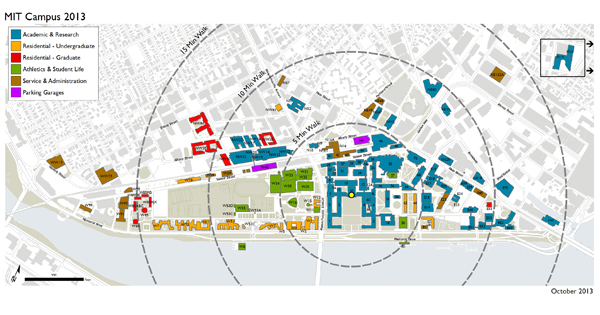The framework
Envisioning the future
MIT academic and administrative leaders are working in collaboration to envision how our campus and surroundings could evolve to meet future academic and research needs and continue to foster innovation. The MIT 2030 framework provides guidelines that help focus and clarify our efforts.
Knowing that the future holds countless unknown variables, we designed the framework to be flexible and responsive, providing structure without limiting the possibilities in what has always been—and most likely always will be—a complex and challenging process. Our goal is to ensure that the inevitable evolution of MIT is a guided but communal endeavor: iterative, inclusive, and intelligent.
Between 1998 and 2010, MIT renovated 875,000 gross square feet (gsf) of existing buildings and completed over 2.6 million gsf of new construction. The MIT campus will continue to develop in support of the Institute's research programs and student life and learning initiatives, including undergraduate and graduate student housing improvements.
MIT 2030 framework objectives
- Align campus renewal priorities with current and future academic needs and opportunities
- Pursue an overall development approach that integrates campus planning objectives and MIT real estate activity to continue creating and supporting an innovation ecosystem while fostering fruitful collaborations between MIT and its surrounding community
- Provide thoughtful guidance for the ongoing physical and financial stewardship of the Institute, to ensure the continuity and integrity of its mission
The MIT 2030 framework informs a broad spectrum of projects from individual systems upgrades (including roofs and windows) and the repurposing of spaces and buildings to partial or complete renovations, new construction, and the best use of Institute-owned land and properties. The Department of Facilities works with the Office of the Vice President for Finance, MIT Investment Management Company (MITIMCo, MIT’s investment arm, which manages the Institute's investment portfolio including real estate), and other stakeholders to identify the Institute’s current academic priorities and development goals. When a top priority emerges, a working group of key stakeholders charged by the Committee for the Review of Space Planning (CRSP) and the Building Committee is formed to explore various ways to address that priority, including the use of existing spaces and land. The group will gather feedback, analyze options, and prepare recommendations for CRSP and the Building Committee to review. Participants in this process are guided by the following principles:
- Where possible, address facilities requirements through renewal and renovation
- Accelerate systematic capital renewal programs (renewal of roofs, elevators, other systems)
- Create flexible science and technology research space that responds to innovative academic and collaborative initiatives
The Department of Facilities, the Office of the Vice President for Finance, MITIMCo, CRSP, and the Building Committee work together to determine the feasibility of recommended options. After reviewing their findings, the Executive Committee of the MIT Corporation approves a preliminary list of projects to move forward into capital planning.
Origins
In 2008, the Academic Council—consisting of the Institute's senior leadership—undertook a thorough review of the academic goals and priorities for each school. Academic leaders worked with the Department of Facilities campus planning and design team to assess our campus and identify shortfalls between current facilities and academic needs; these gaps became the basis for ongoing planning.
At the same time, MITIMCo was evaluating MIT's local investment property holdings to determine how these properties could best be managed to create and integrate research, commercial, living, and learning opportunities in support of our mission.
MIT 2030 is a living framework that guides our planning activities, with a focus on fulfilling the MIT mission and keeping the innovation engine running well into the 21st century.Israel Ruiz, Executive Vice President and Treasurer, Building Committee Chair
The Department of Facilities and MITIMCo then worked closely with CRSP, the Building Committee, and the Office of the Vice President for Finance to generate options for future capital planning. Through this process, certain goals and guiding principles emerged as a way to continuously align the Institute's physical development with its mission—and the MIT 2030 framework was established. As a living framework, its specific tenets are not set in stone and will change as the world changes. But its fundamental purpose will remain constant, and it will continue to guide MIT senior leadership in the evolution of the campus and its surrounding environment over the next several decades.


